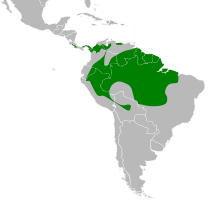Marbled wood quail
| Marbled wood quail | |
|---|---|

| |
| Scientific classification | |
| Domain: | Eukaryota |
| Kingdom: | Animalia |
| Phylum: | Chordata |
| Class: | Aves |
| Order: | Galliformes |
| Family: | Odontophoridae |
| Genus: | Odontophorus |
| Species: | O. gujanensis
|
| Binomial name | |
| Odontophorus gujanensis (Gmelin, JF,1789)
| |

| |
Themarbled wood quail(Odontophorus gujanensis), also known as the Amazonian wood quail, is a species of bird in theNew World quailfamily. It has an extensive distribution in Central America and the northern part of South America. Its naturalhabitatis subtropical or tropical moist lowland forests.
Taxonomy
[edit]The marbled wood quail wasformally describedin 1789 by the German naturalistJohann Friedrich Gmelinin his revised and expanded edition ofCarl Linnaeus'sSystema Naturae.He placed it with the other quail like birds in thegenusTetraoand coined thebinomial nameTetrao gujanensis.[2]Gmelin based his description on theComte de Buffon's"Le Tocro ou Perdrix de la Guyane" andJohn Latham's"Guiana partridge".[3][4]The marbled wood quail is now placed with around 14 other species in the genusOdontophorusthat was introduced in 1816 by the French ornithologistLouis Pierre Vieillot.[5][6]The genus nameOdontophorusis fromAncient Greekmeaning "bearing teeth", fromodous"tooth" andpherō"to carry". The specific epithetgujanensismeans "from the Guianas".[7]
Eightsubspeciesare recognised:[6]
- O. g. castigatusBangs,1901 – southwest Costa Rica and northwest Panama
- O. g. marmoratus(Gould,1843) – east Panama, north Colombia and northwest Venezuela
- O. g. mediusChapman,1929 – south Venezuela and northwest Brazil
- O. g. gujanensis(Gmelin, JF, 1789) – southeast Venezuela, the Guianas, Brazil and n Paraguay
- O. g. buckleyiChubb, C,1919 – south, east Colombia, east Ecuador and north Peru
- O. g. rufogularisBlake,1959 – northeast Peru
- O. g. pachyrhynchusTschudi,1844 – east-central Peru and west Bolivia
- O. g. simonsiChubb, C, 1919 – north, east Bolivia
Description
[edit]Adult marbled wood quails grow to a length of between 23 and 29 cm (9 and 11 in). The bill is stout and dark-coloured and the legs and feet are bluish-grey. The iris of the eye is brown and there is orange or red bare skin around the eye. The sexes are similar in appearance; the front of the crown and cheeks are reddish-brown and the dark brown,vermiculatedfeathers on the crown are ruffled to form a short, loose crest. The mantle and neck are greyish-brown, the back and wings are brown with black vermiculations and the rump and upper-tail coverts are indistinctly spotted with paler colour. The underparts are drab brown with some indistinct barring in buff and darker brown. Juvenile birds are similar in appearance to the adults but have reddish-orange bills and non-vermiculated, reddish-brown crests.[8]
Distribution and habitat
[edit]The marbled wood quail has an extensive distribution in Central America and the northern part of South America. Its range extends from Costa Rica and Panama, where it is feared extinct, to Colombia, Venezuela, Peru, the Guianas and Brazil.[1]It is a ground-dwelling bird, inhabiting theundergrowthin lowland rainforests and cloud forests, occurring at elevations of up to 900 m (3,000 ft) in Ecuador, 1,500 m (4,900 ft) in Colombia and 1,500 m (4,900 ft) in Venezuela.[8]
Behavior and ecology
[edit]The marbled wood quail is an elusive bird, moving about in the undergrowth and seldom seen, but its distinctive calls can often be heard, particularly at dawn and dusk. It sometimes emerges into the open but stays close to fallen trees or scrub to facilitate an easy retreat. On disturbance, it tends to move away quietly on foot, but will burst into flight if necessary. It usually occurs in small groups that move in single file, foraging through theleaf litterforinvertebratesand fallen fruits. Nests are sometimes found at the foot of a tree, with about four white eggs, sometimes spotted with brown, in a shallow scrape concealed under a roof of dead leaves; the breeding season varies with locality.[8]
Status
[edit]The total number of marbled wood quails are thought to be decreasing as their forest habitat in theAmazon basinis increasingly being cleared to provide grazing land for cattle and agricultural land forSoybeanproduction. They are to some extent adaptable to living in secondary growth forest, but the increasing road network puts them at risk of increased hunting. TheInternational Union for Conservation of Natureexpects the population to dwindle by 25 to 30% over the next three generations of birds and has assessed their conservation status as being "near threatened".[1]
References
[edit]- ^abcBirdLife International (2021)."Odontophorus gujanensis".IUCN Red List of Threatened Species.2021:e.T22679630A194056237.Retrieved11 November2021.
- ^Gmelin, Johann Friedrich(1789).Systema naturae per regna tria naturae: secundum classes, ordines, genera, species, cum characteribus, differentiis, synonymis, locis(in Latin). Vol. 1, Part 2 (13th ed.). Lipsiae [Leipzig]: Georg. Emanuel. Beer. p. 767.
- ^Buffon, Georges-Louis Leclerc de(1778)."Le Tocro ou Perdrix de la Guyane".Histoire Naturelle des Oiseaux(in French). Vol. 4. Paris: De l'Imprimerie Royale. p. 513.
- ^Latham, John(1783).A General Synopsis of Birds.Vol. 2, Part 2. London: Printed for Leigh and Sotheby. p. 776.
- ^Vieillot, Louis Pierre(1816).Analyse d'une Nouvelle Ornithologie Élémentaire(in French). Paris: Deterville/self. p. 51.
- ^abGill, Frank;Donsker, David;Rasmussen, Pamela,eds. (January 2022)."Megapodes, guans, guineafowl, New World quail".IOC World Bird List Version 12.1.International Ornithologists' Union.Retrieved5 July2022.
- ^Jobling, James A. (2010).The Helm Dictionary of Scientific Bird Names.London: Christopher Helm. pp.280,181.ISBN978-1-4081-2501-4.
- ^abcMcGowan, Phil; Madge, Steve (2010).Pheasants, Partridges & Grouse: Including buttonquails, sandgrouse and allies.Bloomsbury Publishing. pp. 400–401.ISBN978-1-4081-3566-2.

